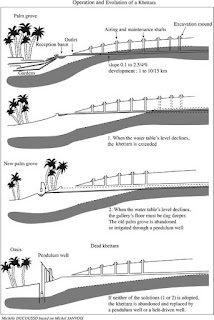Ancient Ways of Water Management
For this post, I am going to move my focus to an entirely opposite geographical location and period in the African continent than the ones I have looked at before. I am going to delve into the historical water resource management in Morocco. Morocco is largely mountainous due to the presence of the Atlas mountains. These mountains form valleys that are inhabited by large populations. Outside the rocky terrain, the semi-arid regions in the country are also home to several oases. The land is able to sustain more agriculture than other places on the continent. The climate tends to be slightly variable in terms of rainfall with high temperatures during the summer, although the cool sea breeze brings respite from the temperatures for now.
Farmers in Morocco have been aware of water resource management for a long time. The history of how the technology for khettaras or qanats (as they are called in Iran) came to Morocco is still contested. Moroccans began constructing these underground systems of tunnels in the Tafilfat oasis in the 14th century. Although, the earliest of these structures are believed to have appeared in Marrakesh around the 12th century. A khettara system involves a series of canals constructed underground with gentle slopes to divert water flow with just simple gravity. This is possible because of the variable terrain of the land. The gently inclined tunnels run along the slopes of the terrain. When they hit the water table, gravity pushes water down the slopes towards the lower altitude. These are also usually accompanied by a vertical shaft leading to a well, or the tunnels directly lead the water towards farmland.
In recent years, Morocco has experienced a boom in its agricultural industry. The Green Morocco Plan was the cutting-edge agricultural scheme launched by the government in 2008. This scheme targetted water stress as the limiting factor for increased agricultural productivity. The plan lays out ways of modernizing the irrigation practices of the country. This has resulted in millions of hectares of olive tree plantations, along with cereal and fruit plantation which had not been grown at this quantity before. Traditionally, the agricultural industry in Morocco has focussed on plantations that do not depend on the rainfall. In my next blog post, I will look into the implications of this industrial change in the context of climate change in Morocco.
References:
Farmers in Morocco have been aware of water resource management for a long time. The history of how the technology for khettaras or qanats (as they are called in Iran) came to Morocco is still contested. Moroccans began constructing these underground systems of tunnels in the Tafilfat oasis in the 14th century. Although, the earliest of these structures are believed to have appeared in Marrakesh around the 12th century. A khettara system involves a series of canals constructed underground with gentle slopes to divert water flow with just simple gravity. This is possible because of the variable terrain of the land. The gently inclined tunnels run along the slopes of the terrain. When they hit the water table, gravity pushes water down the slopes towards the lower altitude. These are also usually accompanied by a vertical shaft leading to a well, or the tunnels directly lead the water towards farmland.
Taken from El Faiz, Mohammad, and Ruf, Thierry (2009)
In recent years, Morocco has experienced a boom in its agricultural industry. The Green Morocco Plan was the cutting-edge agricultural scheme launched by the government in 2008. This scheme targetted water stress as the limiting factor for increased agricultural productivity. The plan lays out ways of modernizing the irrigation practices of the country. This has resulted in millions of hectares of olive tree plantations, along with cereal and fruit plantation which had not been grown at this quantity before. Traditionally, the agricultural industry in Morocco has focussed on plantations that do not depend on the rainfall. In my next blog post, I will look into the implications of this industrial change in the context of climate change in Morocco.
References:
- El Faiz, Mohammed, and Thierry Ruf. "An introduction to the Khettara in Morocco: two contrasting cases." Water and Sustainability in Arid Regions. Springer, Dordrecht, 2010. 151-163.
- Guessous, Hamza. "Morocco’s Agricultural Output Reached MAD 125 billion in 2018." Morocco World News, 2019. Available at: https://www.moroccoworldnews.com/2019/04/270839/morocco-agricultural-irrigation-green-plan/.
- Enaji, Kawtar. "The ‘Green Morocco’ Plan Strengthens Localized Irrigation." Morocco World News, 2019. Available at: https://www.moroccoworldnews.com/2019/08/280816/green-morocco-plan-localized-irrigation/.



Comments
Post a Comment